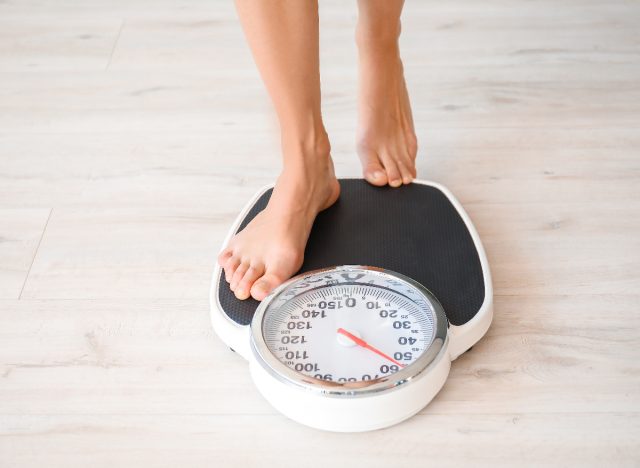How To Lose One Pound in a Week—Adding Up to Gradual Weight Loss That Lasts

Losing a pound a week might seem daunting, but what if we told you sustainable weight loss is simpler than you might think? In this weight loss guide, we'll explore an approach that doesn't involve extreme diets or grueling workout routines—just healthy and sustainable lifestyle habits. We spoke with Tracie Haines-Landram, CSCS, a certified strength and conditioning specialist and nutrition coach with Barbend, who reveals how to lose one pound in a week—adding up to gradual weight loss that lasts. When done consistently, this method can lead to lasting results without stress and frustration.
Shedding one pound per week might sound modest, but it aligns with a sustainable and healthier approach to weight management. It's about creating a calorie deficit that isn't overly restrictive, allowing you to enjoy a variety of foods and have fun while progressing toward your goals. However, losing one pound a week is about more than just the number on the scale; it's about undertaking a holistic journey toward a healthy, thriving lifestyle that lasts in the long term.
Read on to uncover Haines-Landram's expert tips for how to lose one pound in a week. Then, don't miss How To Lose One Pound a Week Without Ever Exercising.
How many calories do you need to burn to lose one pound of body fat?

Haines-Landram explains that there are approximately 3,500 calories in one pound of body fat. That means you must consume 3,500 fewer calories than you consume a week to lose one pound over several days. A good goal is a calorie deficit of 500 a day.
"To lose one pound, you need to create a deficit of 3,500 calories a week through a combination of reduced calorie intake and increased physical activity," says Haines-Landram. "If you break that down per day, it is about a 500-calorie deficit, which is best created by a combination of consuming fewer calories through proper nutrition and burning more calories through physical activity. However, it's essential to approach weight loss sustainably and healthily. Keep in mind that individual variations exist, and factors like metabolism and body composition play a role in the rate of fat loss."
1. Track your food intake.

Tracking your food intake provides a clear picture of your daily calorie consumption, helping you make informed choices. To put this into practice, jot down what you eat at each meal, how much, and how you feel after.
"Tracking your food in a nutrition tracker can be a powerful tool in achieving weight loss goals, combining science with a dash of practicality," Haines-Landram states. "Our phones are by our side daily, and using them to quantify how many calories we consume is educational and can help ensure you're in a sustainable deficit for fat loss. Food tracking can also promote mindfulness, helping you make informed choices about portion sizes, nutrient distribution, and overall food quality."
2. Cut out empty calories.

Stay clear of ultra-processed junk food and sugary snacks. These foods are often high in added sugars, oils, and empty calories, providing little nutrition. Instead, choose nutrient-dense options that fuel your body and support healthy weight management.
"To help create a caloric deficit, the first place to start trimming excess intake is from 'empty calories,' or foods that contribute calories without offering health benefits, such as alcohol, sodas, candy, baked goods, and foods with added sugars," says Haines-Landram. "You can look for added sugars by checking the Nutrition Facts panel and aim to stay below 10 percent of your daily calorie goal from added sugars."
3. Establish a support system.

Whether it's a workout buddy, a friend who shares your goals, or an online community, having support from others can be an invaluable asset toward achieving your weight loss goals.
Haines-Landram tells us, "You don't have to embark on a weight loss journey alone or start from scratch. Join a community for support, whether in person or online. You can sign up for nutrition coaching through reputable online providers, community-based programs, or your local fitness facility. A support system can provide accountability and motivation and links you to others with similar goals."
4. Schedule your workouts.

Treat your workouts like important appointments. Haines-Landram suggests scheduling dedicated time for physical activity, whether it's a brisk walk, a gym session, or a home workout. This habit helps ensure your workouts become non-negotiable and consistent.
"The American Heart Association's recommendation for physical activity is to aim for at least 150 minutes of moderate-intensity aerobic activity per week (increased to 300 minutes per week for weight loss) and to engage in moderate to high-intensity muscle-strengthening activities at least two days per week," Haines-Landram explains. "This equates to about 30 to 60 minutes of daily exercise five days a week with two days a week of strength training. Schedule these workouts into your calendar for the week."
5. Move throughout the day.

If you want to lose one pound in a week, add more movement to your day—and don't restrict your daily movement to just structured workouts. Moving throughout the day adds up and contributes to overall calorie burn while promoting an active, healthy lifestyle.
"It may not be feasible to dedicate an hour to the gym daily, but the good news is you can increase physical activity throughout your day in short bursts that on their own may not feel meaningful but over the accumulation of the day add up," says Haines-Landram. "For example, consider putting on earbuds and walking while having phone conversations, requesting a 'walking meeting' instead of traditional seated meetings, strolling around the field while your kids are at soccer practice, or trying out a treadmill desk."









